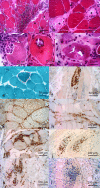Autoimmune Myopathies: Where Do We Stand?
- PMID: 27379096
- PMCID: PMC4905946
- DOI: 10.3389/fimmu.2016.00234
Autoimmune Myopathies: Where Do We Stand?
Abstract
Autoimmune diseases (AIDs) as a whole represent a major health concern and remain a medical and scientific challenge. Some of them, such as multiple sclerosis or type 1 diabetes, have been actively investigated for many decades. Autoimmune myopathies (AIMs), also referred to as idiopathic inflammatory myopathies or myositis, represent a group of very severe AID for which we have a more limited pathophysiological knowledge. AIM encompass a group of, individually rare but collectively not so uncommon, diseases characterized by symmetrical proximal muscle weakness, increased serum muscle enzymes such as creatine kinase, myopathic changes on electromyography, and several typical histological patterns on muscle biopsy, including the presence of inflammatory cell infiltrates in muscle tissue. Importantly, some AIMs are strongly related to cancer. Here, we review the current knowledge on the most prevalent forms of AIM and, notably, the diagnostic contribution of autoantibodies.
Keywords: autoantibodies; dermatomyositis; inclusion-body myositis; myositis; necrotizing myopathy.
Figures


References
Publication types
LinkOut - more resources
Full Text Sources
Other Literature Sources

